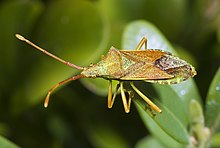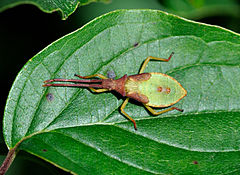Gonocerus acuteangulatus
| Gonocerus acuteangulatus | |
|---|---|

| |
| An adult box bug | |
| Scientific classification | |
| Domain: | Eukaryota |
| Kingdom: | Animalia |
| Phylum: | Arthropoda |
| Class: | Insecta |
| Order: | Hemiptera |
| Suborder: | Heteroptera |
| Family: | Coreidae |
| Genus: | Gonocerus |
| Species: | G. acuteangulatus
|
| Binomial name | |
| Gonocerus acuteangulatus (Goeze, 1778)
| |
Gonocerus acuteangulatus is a herbivorous species of true bug in the family Coreidae.[1] It is commonly known as the box bug in the UK as it once only occurred in Box Hill in Surrey where it fed on box trees.[2]
Taxonomy[edit]
This species was formally described by the German zoologist Johann Goeze in 1778, under the name Cimex acuteangulatus.[3]
Distribution[edit]
This species commonly occurs throughout the Mediterranean region and extends to Central Asia and parts of northwestern Europe.[4][5]
Habitat[edit]

These heat-loving bugs inhabit mainly dry and warm, south-exposed environments, bushes and forest edges with shrubs that bear berries and small trees of various families, especially Buxaceae and Rhamnaceae, as well as Rosa canina and Crataegus species (Rosaceae) or Lonicera xylosteum (Caprifoliaceae).[1]
Description[edit]
Gonocerus acuteangulatus is a medium-sized insect, between 11 and 14 mm long as an adult. These bugs are speckled reddish-brown with a slightly expanded abdomen. The nymphs have a green abdomen.[6] This species is rather similar to Coreus marginatus, but it shows a narrower abdomen and has sharper lateral margins of the pronotum (hence the Latin species name acuteangulatus).

Biology[edit]
Adults can be found all year. They mainly feed on the juice of the ripe fruits of the host plants. This species is a harmful pest of the hazel[7] and pistachio. It can also be a vector of the fungus Nematospora coryli, an agent of stigmatomycosis.[8][9]
Gallery[edit]

-
Mating
-
Nymph with exuvia.
-
Late instarnymph
-
Video clip
Bibliography[edit]
- Ekkehard Wachmann, Albert Melber, Jürgen Deckert: Wanzen. Band 3: Pentatomomorpha I: Aradoidea (Rindenwanzen), Lygaeoidea (Bodenwanzen u. a.), Pyrrhocoroidea (Feuerwanzen) und Coreoidea (Randwanzen u. a.). Goecke & Evers, Keltern 2007, ISBN 978-3-937783-29-1.
- Ekkehard Wachmann, Albert Melber, Jürgen Deckert: Wanzen. Band 5: Supplementband. Dipsocoromorpha, Nepomorpha, Gerromorpha, Leptopodomorpha, Cimicomorpha und Pentatomomorpha. Goecke & Evers, Keltern 2012, ISBN 978-3-937783-58-1.
References[edit]
- ^ a b Livermore L.J.R., Lemaître V.A., Dolling W.R. e Webb M.D. Coreoidea Species File Online
- ^ Hawkins, Roger (2003). Shieldbugs of Surrey. Surrey Wildlife Trust.
- ^ Goeze, Johann (1778). Entomologische Beyträge zu des Ritter Linné zwölften Ausgabe des Natursystems (in German). Vol. 2. Leipzig: Weidmanns Erben & Reich.
- ^ Fauna europaea
- ^ Moulet, Pierre (1995). Faune de France: Hémiptères Coreoidea (Coreidae, Rhopalidae, Alydidae) Pyrrhocoridae, Stenocephalidae: Euro-Méditerranéens (in French). Vol. 81. Paris: Fédération Française des Sociétés de Sciences Naturelles.
- ^ Tristan Bantock & Joseph Botting. "British Bugs". Retrieved 17 December 2013.
- ^ Hamidi, Rachid; Calvy, Mélina; Valentie, Emma; Driss, Laetitia; Guignet, Jonas; Thomas, Maud; Tavella, Luciana (2022-03-23). "Symptoms resulting from the feeding of true bugs on growing hazelnuts". Entomologia Experimentalis et Applicata. 170 (6): 477–487. Bibcode:2022EEApp.170..477H. doi:10.1111/eea.13165. ISSN 0013-8703. S2CID 247567135.
- ^ Antonio Servadei; Sergio Zangheri; Luigi Masutti. Entomologia generale ed applicata. Padova, CEDAM, 1972, 320-321. (in Italian)
- ^ Ermenegildo Tremblay. Entomologia applicata. Volume II Parte I. 1a ed. Napoli, Liguori Editore, 1981, 61-63. ISBN 978-88-207-1025-5. (in Italian)



